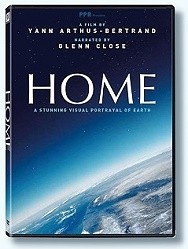| Save Our Planet | |
Home: ‘Please, Listen to Me’
|
 |
“Home,” a highly acclaimed new documentary on the environment co-produced by the famed French director Luc Besson, was released simultaneously in over 50 countries on the symbolic date of June 5, 2009, World Environment Day. In an effort to globally reach the most number of people in one day, access to the film was made easy on every format including movie theatres, TV, DVD and the Internet, mostly free of charge, an unprecedented way of distribution. Under the direction of the award-winning photographer turned aerial cinematographer, Yann Arthus-Bertrand, the filming process was allowed devout artistic freedom. According to Bertrand, the movie has a mission, “What I really want is for the people, whose consumption has a direct impact on the Earth, to feel the need to change their way of life after seeing the movie.”
The rhythmic pacing of the scenes, the poetic narration, the ambient score and the artistic aerial footage of over 54 countries are all threaded together to capture and release the many disappearing and spectacular facets of our only home, and also, its now visible wounds. The repetitive words throughout the film, “Faster and faster,” introduce each convenient way that we’ve chosen to deplete our planet for our personal comforts and seem to reflect the pace of these acts.
“The more a country develops, the more meat its inhabitants consume ...Faster and faster, like the life cycle of livestock which many never see a meadow, manufacturing meat faster than the animal has become a daily routine.” This documentary exposes meat production as a major, expensive habit of developed nations that exhausts our natural resources. With supporting figures, viewers are encouraged to do the calculations: It takes 100L of water to produce 1kg of potatoes, 4,000L of water to produce 1kg of rice, but it takes 13,000L of water to produce 1kg of beef, not to mention the oil consumed in its production and transport process.
The documentary further frames our current predicament--our dependence on non-renewable energy and our reliance on unsustainable practices. Fossil fuels contribute greatly to the carbon dioxide being pumped into the atmosphere as do transport, industry, deforestation and agriculture. The accumulation of greenhouse gases has raised the world’s temperature and sea levels by melting the polar ice caps and glacier sheets. Coastal cities and low-lying lands around the globe are at great risk of submerging, not to mention the water shortage that could occur when our drinking water becomes saline with sea salt.
The most dangerous part, as the narrator points out, is the melting of permafrost, causing the release of a gas at least 20 times more powerful than carbon dioxide, which is methane gas, in unpredictable quantities, and the cost to humans and animals alike.
 |
Many pertinent points are presented throughout the documentary “Home.” “The cost of our actions is high,” and shall we as consumers ignore the price paid by less fortunate fellow beings in our pursuit of happiness? Can we also ignore the inhumane treatment of animals and still consume them as meat, albeit causing major environmental devastation? Graphic scenes show the crowded ranches and numbers of livestock. The audience is gently nudged to see and think for themselves. If we stopped eating meat, we could eradicate world hunger and, most obviously, save our planet. The narrator reminds us of the Rapanuis who used to reside on the isolated Easter Island. This civilized race of outstanding arts “did not react in time”; thus, they failed to survive the consequences of overpopulation and dwindling resources. This case is similar to our current plight and an historical lesson that we must take to heart--this lesson learned, may indeed, be a planet earned.
Director Arthus-Bertrand is also the
current United Nations Environment Program Goodwill Ambassador (UNEP).
In an interview, Bertrand mentioned that the making of “Home”
is carbon offset. He then concluded that the film carries a message, and
emphasized that it was made out of love for everyone. The audience is
to take away with them the message that “what’s important
is not what’s gone, but what remains… We know that the solutions
are there today. We all have the power to change. So what are we waiting
for?” ![]()
For info about this film, please visit: http://www.youtube.com/user/homeproject?blend=2&ob=1
| << | Contents | >> |
|
Refer this page to friends
|
||